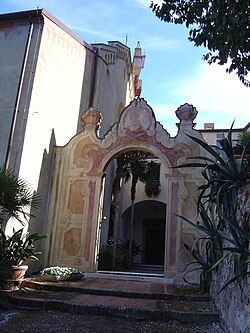Cervara Abbey




Cervara Abbey (Italian: Abbazia della Cervara or Abbazia di San Gerolamo al Monte di Portofino) is a former abbey in Santa Margherita Ligure, Liguria region, northern Italy. It is on the coastal road to Portofino. The abbey complex is a designated National Monument of Italy.
Origin of the name
In the Middle Ages this site, as the whole stretch of coastline on the
History
The monastery building was built in 1361 by Ottone Lanfranco, a priest at the church of
Later, Pope
The monastery was elevated to the rank of abbey in 1546. In the same period it was fortified in response to the increasing inroads made by North African pirates. In the late 18th century, after the
In 1804 French Trappists acquired the abbey and opened a school there, but they remained only until 1811. The complex subsequently became the property of the Diocese of Chiavari and, in 1859, was put up for sale. Marquis Giacomo Filippo Durazzo, a member of the Genoese nobility, acquired it in 1868; three years later he donated it to the Somaschi Fathers. From 1901 to 1937 the abbey was entrusted to the French Carthusians and in 1912 was declared a national monument.
Architecture
The abbey has a consecrated church, a 16th-century cloister, the tower, the main body of the building and a beautiful garden. The abbey was rebuilt for the first time in the 16th century, with more work in the apse, while during the 17th century were changed from the high altar and the choir. In the 18th century were added more decorations in marble and complete painting of the walls.
The church has a Latin cross plan, made by striking apse angle that simulates the bowed head of Christ. The columns separating the three naves appear to be built with blocks alternating slate and marble, in the typical architectural style of Liguria, are actually two colors of brick covered with plaster.
During the recent restoration work was discovered a burial which in all probability is the archbishop of Genoa
The abbey's
It is located at the entrance of the complex, opposite the entrance of the Church. It was built in the 16th century to defend against raids by Saracen pirates, and despite his sighting function has the distinction of being set back from the monastery, it is considered a sign of respect and subordination to the sacredness of it.
The cloister is quadrangular in shape and two orders of levels. The marble decoration dates from an 18th-century restoration.
Gardens
Italian Garden
What was once the garden of the Benedictine monks is now the only monumental
The Italian garden is simple, linear, and proportionate. The Garden Monumental is created with hedges of boxwood (Buxus sempervirens L.) and refined achievements of topiary cones and cones surrounding the 17th century marble fountain depicting a putto.
Around the garden and the main building, terraces and gardens alternate framed pergolas, columns painted or brick, rare plants and blooms that steal exceptional attention depending on the season. A shaded
Herb garden
The monks' orchard has been preserved and enhanced with a collection of citrus trees. On the side facing the mountain, it has been kept a traditional vegetable garden where the monks since the Middle Ages grew the "simple" (plant varieties with medicinal virtues), medicinal plants and herbs of the promontory of Portofino, low box hedges and particles alternating crops such rare species of citrus in terracotta pots, as was customary in monasteries.
Among the herbs are:
Garden of the Hesperides
The Garden of the
Natural area
In the upper area the landscape is set in a land once cultivated in rows and in an ancient Mediterranean forest. Native
, and other species predominate. Each has a habitat niche in which it thrives and flourishes. Fauna large and small is in this natural area. The rare butterfly Charaxes jasius feeds only on the leaves of strawberry trees. The hoopoe and a host of various other birds are heard, but rarely seen. Tracks of fox and wild boar are often seen.Present day
The abbey is now privately owned, and is open to the public for cultural performances, concerts, and visits in small groups by appointment. Also private events are hosted indoors and in the gardens, such as weddings, business meetings, and conferences.
Restoration
The current owners began restoration work upon buying the Abbey, to return the monastery to its historical beauty. The restoration has as the goal the full recovery of the monument. The structural architect is Mide Osculati. The painting restorer is Pinin Brambilla Barcilon, who was the director of the restoration of
In 2011 the prison of
Famous guests
The prestige of San Girolamo della Cervara Abbey and its outstanding location, made it a preferred destination for the passage of illustrious personages, whose visits are written in the pages of local journals. They include:
There were also those who stopped at Cervara against their will, including: King Francis I of France after being defeated by Charles V of Spain at the Battle of Pavia in 1525, waiting to leave for Spain, had the misfortune to be imprisoned in the small tower overlooking the sea for a week.
More recently, weddings of the famous include: the singer
References
- ^ Richardson, Carol M. (2007). Locating Renaissance art. Yale University Press. Retrieved March 19, 2012.
